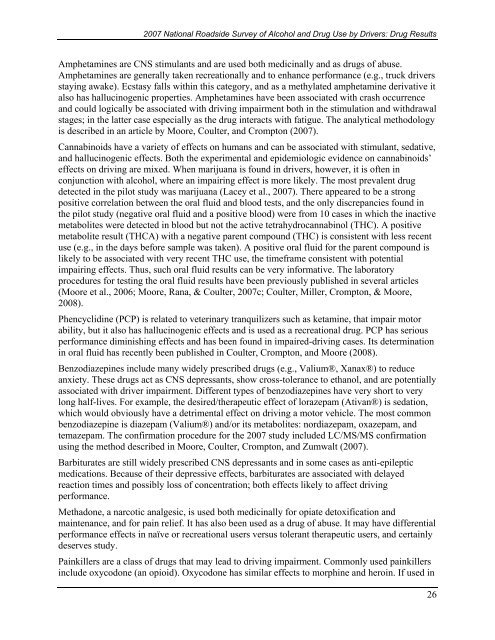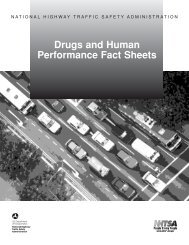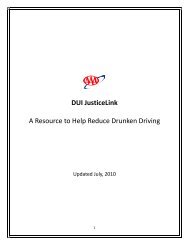2007 National Roadside Survey of Alcohol and Drug Use by Drivers
2007 National Roadside Survey of Alcohol and Drug Use by Drivers
2007 National Roadside Survey of Alcohol and Drug Use by Drivers
Create successful ePaper yourself
Turn your PDF publications into a flip-book with our unique Google optimized e-Paper software.
<strong>2007</strong> <strong>National</strong> <strong>Roadside</strong> <strong>Survey</strong> <strong>of</strong> <strong>Alcohol</strong> <strong>and</strong> <strong>Drug</strong> <strong>Use</strong> <strong>by</strong> <strong>Drivers</strong>: <strong>Drug</strong> ResultsAmphetamines are CNS stimulants <strong>and</strong> are used both medicinally <strong>and</strong> as drugs <strong>of</strong> abuse.Amphetamines are generally taken recreationally <strong>and</strong> to enhance performance (e.g., truck driversstaying awake). Ecstasy falls within this category, <strong>and</strong> as a methylated amphetamine derivative italso has hallucinogenic properties. Amphetamines have been associated with crash occurrence<strong>and</strong> could logically be associated with driving impairment both in the stimulation <strong>and</strong> withdrawalstages; in the latter case especially as the drug interacts with fatigue. The analytical methodologyis described in an article <strong>by</strong> Moore, Coulter, <strong>and</strong> Crompton (<strong>2007</strong>).Cannabinoids have a variety <strong>of</strong> effects on humans <strong>and</strong> can be associated with stimulant, sedative,<strong>and</strong> hallucinogenic effects. Both the experimental <strong>and</strong> epidemiologic evidence on cannabinoids’effects on driving are mixed. When marijuana is found in drivers, however, it is <strong>of</strong>ten inconjunction with alcohol, where an impairing effect is more likely. The most prevalent drugdetected in the pilot study was marijuana (Lacey et al., <strong>2007</strong>). There appeared to be a strongpositive correlation between the oral fluid <strong>and</strong> blood tests, <strong>and</strong> the only discrepancies found inthe pilot study (negative oral fluid <strong>and</strong> a positive blood) were from 10 cases in which the inactivemetabolites were detected in blood but not the active tetrahydrocannabinol (THC). A positivemetabolite result (THCA) with a negative parent compound (THC) is consistent with less recentuse (e.g., in the days before sample was taken). A positive oral fluid for the parent compound islikely to be associated with very recent THC use, the timeframe consistent with potentialimpairing effects. Thus, such oral fluid results can be very informative. The laboratoryprocedures for testing the oral fluid results have been previously published in several articles(Moore et al., 2006; Moore, Rana, & Coulter, <strong>2007</strong>c; Coulter, Miller, Crompton, & Moore,2008).Phencyclidine (PCP) is related to veterinary tranquilizers such as ketamine, that impair motorability, but it also has hallucinogenic effects <strong>and</strong> is used as a recreational drug. PCP has seriousperformance diminishing effects <strong>and</strong> has been found in impaired-driving cases. Its determinationin oral fluid has recently been published in Coulter, Crompton, <strong>and</strong> Moore (2008).Benzodiazepines include many widely prescribed drugs (e.g., Valium®, Xanax®) to reduceanxiety. These drugs act as CNS depressants, show cross-tolerance to ethanol, <strong>and</strong> are potentiallyassociated with driver impairment. Different types <strong>of</strong> benzodiazepines have very short to verylong half-lives. For example, the desired/therapeutic effect <strong>of</strong> lorazepam (Ativan®) is sedation,which would obviously have a detrimental effect on driving a motor vehicle. The most commonbenzodiazepine is diazepam (Valium®) <strong>and</strong>/or its metabolites: nordiazepam, oxazepam, <strong>and</strong>temazepam. The confirmation procedure for the <strong>2007</strong> study included LC/MS/MS confirmationusing the method described in Moore, Coulter, Crompton, <strong>and</strong> Zumwalt (<strong>2007</strong>).Barbiturates are still widely prescribed CNS depressants <strong>and</strong> in some cases as anti-epilepticmedications. Because <strong>of</strong> their depressive effects, barbiturates are associated with delayedreaction times <strong>and</strong> possibly loss <strong>of</strong> concentration; both effects likely to affect drivingperformance.Methadone, a narcotic analgesic, is used both medicinally for opiate detoxification <strong>and</strong>maintenance, <strong>and</strong> for pain relief. It has also been used as a drug <strong>of</strong> abuse. It may have differentialperformance effects in naïve or recreational users versus tolerant therapeutic users, <strong>and</strong> certainlydeserves study.Painkillers are a class <strong>of</strong> drugs that may lead to driving impairment. Commonly used painkillersinclude oxycodone (an opioid). Oxycodone has similar effects to morphine <strong>and</strong> heroin. If used in26




